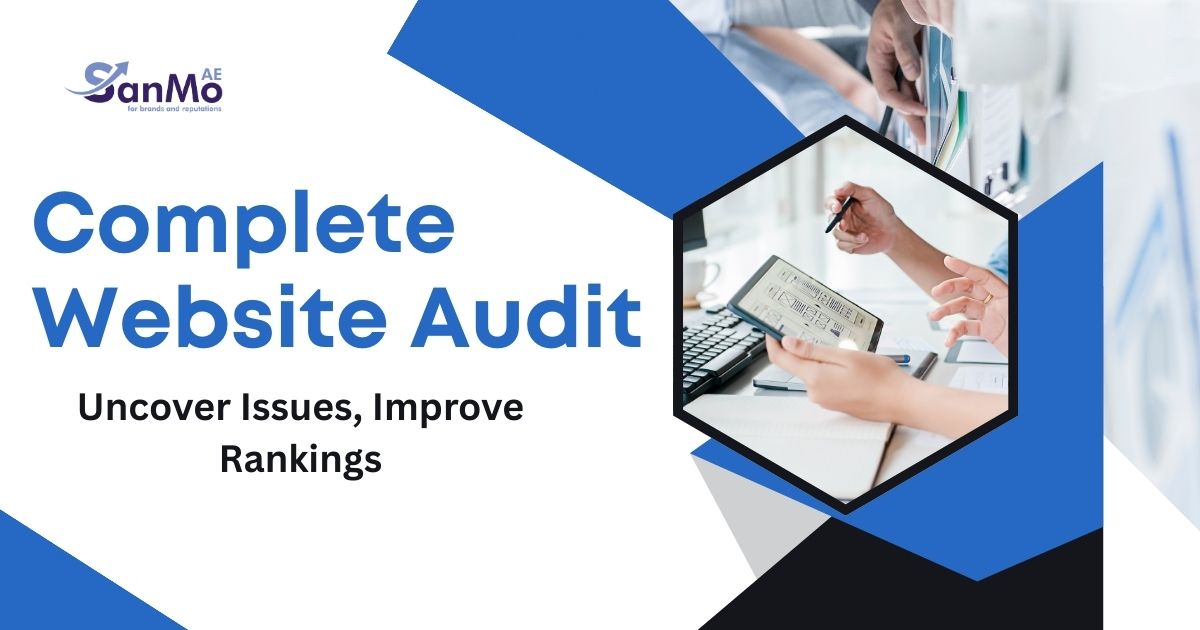Your website might be silently losing visitors, customers, and revenue right now. Hidden technical issues, slow loading times, and poor user experience can drive potential customers away before they even see what you offer. A complete website audit reveals these problems and provides a clear roadmap for improvement.
Whether you’re running an e-commerce store, a service-based business, or a content site, regular website audits help you identify opportunities for growth and fix issues that hurt your bottom line. This comprehensive guide walks you through every aspect of conducting a thorough website audit, from technical SEO to user experience optimization.
By the end of this post, you’ll have a systematic approach to evaluate your website’s performance and actionable insights to boost your online presence.
Why Website Audits Matter More Than Ever
Websites today face intense competition for user attention. Google processes over 8.5 billion searches daily, and users form opinions about your site within 0.05 seconds of landing on it. A single slow-loading page or broken link can cost you potential customers.
Regular website audits help you:
- Identify technical issues before they impact search rankings
- Improve user experience and reduce bounce rates
- Discover content gaps and optimization opportunities
- Ensure mobile responsiveness across all devices
- Maintain website security and protect user data
Technical SEO: The Foundation of Your Audit
Technical SEO forms the backbone of any complete website audit. These behind-the-scenes elements directly impact how search engines crawl, index, and rank your site.
Site Speed and Core Web Vitals
Page loading speed affects both user experience and search rankings. Google’s Core Web Vitals measure loading performance, interactivity, and visual stability. Use tools like Google PageSpeed Insights to evaluate:
- Largest Contentful Paint (LCP): Should load within 2.5 seconds
- First Input Delay (FID): Should be less than 100 milliseconds
- Cumulative Layout Shift (CLS): Should be less than 0.1
Common speed issues include unoptimized images, excessive plugins, and poor hosting performance. Compress images, minimize HTTP requests, and consider upgrading your hosting plan if necessary.
Crawlability and Indexability
Search engines must be able to discover and understand your content. Check your robots.txt file to ensure you’re not accidentally blocking important pages. Review your XML sitemap and submit it to Google Search Console.
Look for these technical issues:
- Broken internal and external links
- Missing or duplicate meta descriptions
- Incorrect canonical tags
- Pages blocked by robots.txt
- Crawl errors in Google Search Console
Mobile Responsiveness
Over 60% of web traffic comes from mobile devices. Your site must provide an excellent experience across all screen sizes. Google’s Mobile-Friendly Test tool quickly identifies mobile usability issues.
Check for proper viewport settings, readable font sizes, and touch-friendly navigation. Ensure forms are easy to complete on smaller screens and that important content isn’t hidden or cut off.
On-Page SEO Analysis
On-page optimization ensures your content aligns with search intent and follows SEO best practices. A thorough audit examines each page’s optimization potential.
Content Quality and Relevance
Evaluate your content for depth, accuracy, and user value. High-quality content answers user questions comprehensively and provides unique insights. Look for:
- Thin or duplicate content across pages
- Missing or poorly optimized title tags
- Inadequate header structure (H1, H2, H3)
- Low word count on important pages
- Content that doesn’t match search intent
Keyword Optimization
Review how well your pages target relevant keywords. Avoid keyword stuffing while ensuring your primary terms appear in strategic locations like title tags, headers, and throughout the content naturally.
Use tools like Google Search Console to identify which queries drive traffic to your site. Look for opportunities to create new content around high-volume, low-competition keywords in your industry.
Internal Linking Strategy
Strategic internal linking helps search engines understand your site structure and distributes page authority throughout your domain. Audit your internal links to ensure:
- Important pages receive adequate internal link support
- Anchor text is descriptive and relevant
- You’re not overlinking or creating link spam
- Orphaned pages without internal links are identified
User Experience Evaluation
User experience directly impacts conversion rates and search rankings. A complete website audit examines how visitors interact with your site and identifies friction points.
Navigation and Site Structure
Your site’s navigation should be intuitive and help users find information quickly. Evaluate your menu structure, breadcrumb navigation, and search functionality.
Test your site’s user flow by completing common tasks like making a purchase or finding contact information. Note any confusing navigation elements or dead ends that might frustrate visitors.
Content Accessibility
Accessible websites serve all users, including those with disabilities. This isn’t just good practice—it’s often legally required and improves SEO performance.
Check for proper alt text on images, adequate color contrast, and keyboard navigation support. Ensure your site works with screen readers and other assistive technologies.
Conversion Optimization
Examine your conversion funnel to identify where visitors drop off. Analyze contact forms, checkout processes, and call-to-action placement. Small improvements in conversion rate can significantly impact your bottom line.
Look for trust signals like customer testimonials, security badges, and clear privacy policies. These elements help build confidence and encourage conversions.
Security and Performance Monitoring
Website security protects your business and builds user trust. Include security checks in your complete website audit process.
SSL Certificate and HTTPS
Ensure your entire site uses HTTPS encryption. Mixed content warnings can harm user trust and search rankings. Check that all resources load securely and redirect HTTP URLs to HTTPS versions.
Backup and Recovery Systems
Verify that your website backup system works properly. Test restore procedures to ensure you can quickly recover from potential issues. Regular backups protect against data loss from hacking, server failures, or human error.
Plugin and Software Updates
Outdated software creates security vulnerabilities. Review all plugins, themes, and core software for available updates. Remove unused plugins to reduce potential attack vectors.
Analytics and Data Analysis
Your website audit should include a thorough review of analytics data to understand user behavior and identify trends.
Traffic Patterns and Sources
Examine your traffic sources to understand how visitors find your site. Look for changes in organic search traffic, direct visits, and referral traffic. Identify your most valuable traffic sources and optimize accordingly.
User Behavior Metrics
Review metrics like bounce rate, session duration, and pages per session. High bounce rates might indicate poor content quality or slow loading times. Low session duration could suggest navigation issues or content that doesn’t meet user expectations.
Conversion Tracking
Ensure your conversion tracking is properly configured. Set up goals in Google Analytics to measure important actions like form submissions, phone calls, or purchases. Regular monitoring helps you understand which pages and traffic sources drive the most valuable visitors.
Creating Your Action Plan
A complete website audit generates valuable insights, but the real value comes from taking action on your findings. Prioritize issues based on their potential impact and implementation difficulty.
High-Priority Issues
Address these issues first:
- Critical technical errors affecting site functionality
- Security vulnerabilities
- Pages with significant traffic that load slowly
- Broken conversion funnels
Medium-Priority Improvements
Focus on these after resolving critical issues:
- Content optimization opportunities
- Internal linking improvements
- Mobile usability enhancements
- Missing meta descriptions
Long-Term Optimization
Plan these improvements for ongoing optimization:
- Content expansion and creation
- Advanced technical SEO implementations
- User experience enhancements
- Performance monitoring systems
Tools for Comprehensive Website Auditing
Several tools can streamline your audit process:
Free Tools:
- Google Search Console for technical SEO insights
- Google Analytics for user behavior data
- Google PageSpeed Insights for performance testing
- Google Mobile-Friendly Test for mobile optimization
Paid Tools:
- SEMrush or Ahrefs for comprehensive SEO analysis
- Screaming Frog for technical crawling
- Hotjar for user behavior tracking
- GTmetrix for detailed performance analysis
Taking Action on Your Website Audit Results
Your complete website audit provides a roadmap for improvement, but success depends on consistent implementation and monitoring. Start with high-impact issues that directly affect user experience or search rankings.
Document your findings and create a timeline for addressing each issue. Regular audits—quarterly or bi-annually—help you maintain optimal website performance and stay ahead of potential problems.
Remember that website optimization is an ongoing process. Search engine algorithms evolve, user expectations change, and new technologies emerge. Make website audits a regular part of your digital marketing strategy to ensure sustained online success.
The investment in conducting thorough website audits pays dividends through improved search rankings, better user experience, and increased conversions. Start your complete website audit today and unlock your site’s full potential.







